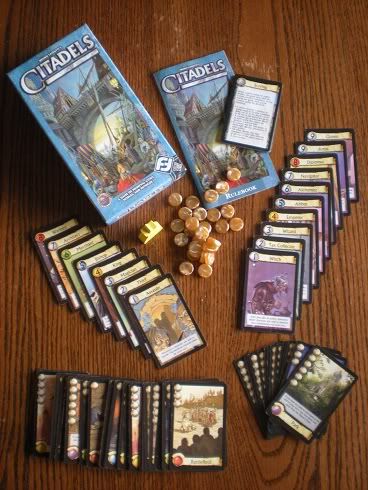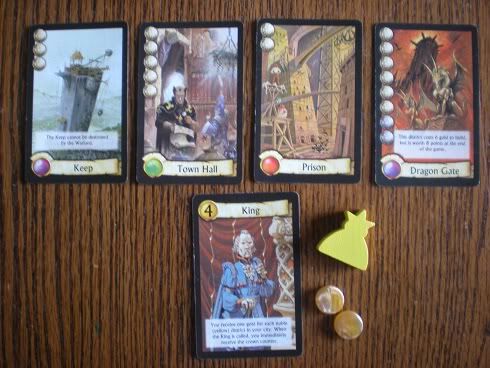Fanning out the four remaining role cards, I sneak a glance at my tableau. Seven districts. One to go. Then I observe that two of my opponents are in a similar situation, albeit with less gold. Between my cash in hand and the two I will earn for my action that round, I have enough to lay down the Fortress - a nice card, but I'm more concerned with getting that 4 point bonus awarded to the first with eight districts. Back to the character cards: the Magician, the King, the Bishop, and the Warlord. Of course, the Assassin and the Thief are both gone already. Perhaps one of them is that face down card in the center of the table? Or did my rotten and conniving kids choose them, after my life and treasure again? So, the Magician it is. He plays third, hopefully getting me that 4 point bonus. Plus I rarely pick him, so surely my scheming and scoundrel children will think I chose another? The remaining roles go round the table. The King calls out for the Assassin. It's Brendon. Of course. He looks astutely around the group, everyone still and quiet (which, by the way is very rare at our house). After pondering intently, he takes his action, builds his sixth district and, with evil glee, calls out, "I assassinate the Magician!" Are you serious?! ARRRGGGHHHH!!!
The Vitals:
- Publisher - Fantasy Flight (2006), with Dark City Expansion
- Designer - Bruno Faidutti
- Players - 2 to 7
- Play Time - 20 to 60 minutes, per the box
- Ages - 10 years and up
What You Get:
 |
| Out of the box. |
- 66 District Cards
- 8 Character Cards
- 8 Reference Cards
- 30 Plastic Gold Coins
- A Nifty "King-Shaped" Wooden Pawn
- 10 Bonus Character Cards (Dark City Expansion)
- 14 Bonus District Cards (Dark City Expansion)
The components are very nice. The cards are a heavy, linen-textured stock. The district cards should hold up very well over time. However, the role cards will see heavy wear as they are routinely shuffled and handled a lot in this game. You will either need to sleeve them or be very gentle, especially as any distinguishing marks or scuffs may jeopardize the identity of a particular card, thus diminishing the point of the secret role selection mechanic. I've told my kids that if they bend or crease one, there will be no ice cream in the house for two months - the money instead going toward a new copy of the game! The artwork is expressive and eye-catching. The butterscotch buttons are fun to handle as gold. And the wooden crown marker is a polished, if unnecessary, touch.
The Quick Rundown:
The goal in
Citadels is to have the most points when you or some one else builds eight districts, triggering the last round of the game. You start with a hand of four district cards and two gold. Each turn, you take an action of either a) taking two gold or b) drawing two district cards, adding one of them to your hand. To build a district, you must pay the cost indicated on the card, which is also how many points that district is worth at the end of the game. You can score bonus points by being the first to build eight districts, completing eight districts in the last round of the game, building at least one of the five different kinds of districts (military, royal, religious, economic, and special), and finally with certain special district cards.
 |
| A starting hand. |
The brilliance of this game, however, is in the character cards. Each round, via a drafting mechanic, the players secretly select a role which will give them a special ability that turn. The Assassin can kill another character, depriving them of their turn. The Thief can steal a character's gold. The Magician can trade cards with the draw pile or another player. The King gets extra gold for each royal district you own, plus first choice of roles on the next round. The Bishop gets extra gold for any religious districts you own, and cannot be attacked by the Warlord. The Merchant gets an extra gold, plus more gold for any economic districts you own. The Architect draws and keeps two extra cards and can build up to three districts if you have the money. And the Warlord receives extra gold for each military district you own, plus may destroy another player's district for the cost of one less gold indicated on that card. The bonus characters replace certain roles from the core game and have similar abilities along the lines of their counterparts.
 |
| A completed city worth 34 points. |
E for Everyone:
Is a character-selection game in which half the roles can mess with you in some fashion good for kids? I'm going to go out on a limb and say, "Yes," although it could be borderline for some. And I actually add that caveat not because of the spite factor, but rather because of the subtlety of the psychology involved. The beauty of this game is in balancing your role selections. Do you simply choose the role needed for an immediate task? Do you grab one that you
think another player is after, in order to deny it to them? Do you pick one of the "attacking" roles just to be ruthless and cruel or set someone down a notch? Do you nab one because you think another player that's after you won't think you would select that character, hoping they will choose the wrong character to kill or steal from? This mental head-game makes Citadels tick with intrigue and tension. Most of the time, my kids seems to understand the psychology of this role selection and play it well - you can almost see the gears turning inside their brains. Every now and then, they miss a subtlety that an adult would not, especially after seventh districts are built. At that point, as the game could end in any round, there is a slightly different dynamic to the nuances of role selection.
The direct interaction could always pose some tears among children. After all, I've read reviews from
adults that don't play this game because they're put off by that mechanic. However, I would argue it should not be a problem for the majority of kids for two reasons. One, it isn't too personal. The Assassin and the Thief must pick a
character to kill and steal from, not a specific player. While the Magician can "steal" your hand, it's not as common and can even help you sometimes. The Warlord can be a pain because he can destroy one of your districts, but you take some solace in the fact that it costs him gold (incidentally that means it's usually of lower point value so he does not have to pay as much to burn it). All in all, this minimizes the ability to "gang up" on some one. And two, the jabs are not constant. This is no war game, so generally the spite is not coming relentlessly like a UFC beatdown. You will have just as much opportunity to use the "attacking" roles as any other. And revenge is sweet indeed!
 |
| Beware these shady looking characters. |
The game should appeal to most kids. The older the better. However, 3 of my 4 kids are under the suggested age printed on the box and do just fine, by and large. Citadels is probably our most played game. The rules are easy to learn and play, while the psychological aspect tacks on a fun, tense, and challenging metagame. At the same time, it is just light enough to ease the pain of the "take that" moments. The production quality is good. You'll be laughing as you snatch a pile of gold from underneath another's nose one turn, or as you're keeling over in your soup and bread from a dagger in your back the next. Unless you're the type that loathes having your life and money taken from you. Plus, it's not a strategy game, if that's what you'd rather play. If you don't draw good district cards, it's going to limit what points you'll earn. If you're solely into theme, you'll probably want to concentrate elsewhere. While the character abilities make sense, the theme of nobles building a medieval city is just sort of "there," and doesn't shape any narrative. And some of the bonuses provided by special district cards have little to do with the name of that particular district. It does not scale as well as some would like, ideally suited more for 5-7 players (personally I still enjoy 2-3 player games). A final, minor point is that game times do vary widely from play to play, depending on number of players and the success rate of trying to "slow down" the leader with attack cards.
Okay, I'll Shut Up Now:
On the
Board Game Geek rating scale, I give this game a 10 (Outstanding. Always want to play and expect this will never change). So far, the only 10 of our, as now, small collection. Because of the nasty side and the mind games, it may not be the first game you'll use to introduce this hobby to kids and non-gamers, but it could easily be a second.




I really appreciate the kind of topics you post here. Thanks for sharing us a great information that is actually helpful. Good day!
ReplyDeleteunblocked games
I love the strategic element of choosing which character card to play.
ReplyDelete